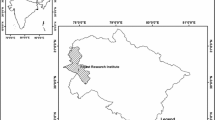Abstract
The objective of this study was to test an artificial neural network (ANN) for converting pan evaporation data (E p) to estimate reference evapotranspiration (ET0) as a function of the maximum and minimum air temperature. The conventional method that uses Pan coefficient (K p) as a factor to convert E p to ET0, is also considered for the comparison. The ANN has been evaluated under semi-arid conditions in Safiabad Agricultural Research Center (SARC) in the southwest of Iran, comparing daily estimates against those from the FAO-56 Penman–Monteith equation (PM), which was used as standard. The comparison shows that, the conventional method underestimated ET0 obtained by the PM method. The ANN method gave better estimates than the conventional method that requires wind speed and humidity data.




Similar content being viewed by others
References
Allen RG, Pereira LS, Raes D, Smith M (1998) Crop evapotranspiration. Guidelines for computing crop water requirements. Irrigation and Drainage Paper No. 56. FAO, Rome
Bruton JM, Mcclendon RW, Hoogenboom G (2000) Estimating daily pan evaporation with artificial neural networks. Trans ASAE 43(2):491–496
Coulibaly P, Anctil F, Bobee B (2000) Daily reservoir inflow forecasting using artificial neural networks with stopped training approach. J Hydrol 230(3–4):244–257
Cybenko G (1989) Approximation by superposition of a sigmoidal function. Math Control Signal Syst 2:303–314
Doorenbos J, Pruitt WO (1977) Guidelines for prediction of crop water requirements. FAO Irrig Drain. Paper No. 24, Rome
Gavilan P, Lorite IJ, Tornero S, Berengena J (2006) Regional calibration of Hargreaves equation for estimating reference ET in a semiarid environment. Agric Water Manage 81:257–281
Hornik K, Stinchcombe M, White H (1989) Multilayer feedforward networks are universal approximators. Neural Netw 2:359–366
Irmak S, Haman D, Jones W (2002) Evaluation of class A pan coefficients for estimating reference evapotranspiration in humid location. J Irrig Drain Eng 128(3):153–159
Irmak S, Allen RG, Whitty EB (2003) Daily grass and alfalfa-reference evapotranspiration estimates and alfalfa-to-grass evapotranspiration ratios in Florida. J Irrig Drain Eng 129(5):360–370
Jensen ME (ed) (1974) Consumptive of water and irrigation water requirements. Irrig Drain Div ASCE, p 227
Jensen MC, Middleton JE, Pruitt WO (1961) Scheduling irrigation from pan evaporation. Circular 386, Washington Agricultural Experiment Station
Keskin ME, Terzi O (2006) Artificial neural network models of daily pan evaporation. J Hydrol Eng 11(1):65–70
Kisi O (2006) Daily pan evaporation modelling using a neuro-fuzzy computing technique. J Hydrol 329(3–4):636–646
Kumar M, Raghuwanshi NS, Singh R, Wallender WW, Pruitt WO (2002) Estimating evapotranspiration using artificial neural network. J Irrig Drain Eng 128(4):224–233
Odhiambo LO, Yoder RE, Hines JW (2001) Optimization of fuzzy evapotranspiration model through neural training with input-output examples. Trans ASAE 44(6):1625–1633
Silva AF (2002) Previsão da evapotranspiração de referência utilizando redes neurais. Dissertação de Mestrado, Univ. Federal de Viçosa, Viçosa, Minas Gerais, Brazil
Sudheer KP, Gosain AK, Ramasastri KS (2003) Estimating actual evapotranspiration from limited climatic data using neural computing technique. J Irrig Drain Eng 29(3):214–218
Trajkovic S, Todorovic B, Stankovic M (2003) Orecasting of reference evapotranspiration by artificial neural networks. J Irrig Drain Eng 129(6):454–457
Utset A, Farre I, Martinez-Cob A, Cavero J (2004) Comparing Penman–Monteith and Priestley–Taylor approaches as referenceevapotranspiration inputs for modeling maize wateruse under Mediterranean conditions. Agric Water Manage 66(3):205–219
Zanetti SS, Sousa EF, Oliveira VPS, Almeida FT, Bernard S (2007) Estimating evapotranspiration using artificial neural network and minimum climatological data. J Irrig Drain Eng 133(2):83–89
Acknowledgments
The author would like to thank the anonymous reviewers for their valuable comments and suggestions which improved the content of the paper. This study is the partial work of Project No. 7351023/1/02 supported by University of Tehran and was done in Department of Irrigation and Drainage Engineering, Faculty of Agricultural Engineering, College of Abourayhan. The meteorological data were provided from Iran Meteorological Organization.
Author information
Authors and Affiliations
Corresponding author
Additional information
Communicated by A. Kassam.
Rights and permissions
About this article
Cite this article
Rahimi Khoob, A. Artificial neural network estimation of reference evapotranspiration from pan evaporation in a semi-arid environment. Irrig Sci 27, 35–39 (2008). https://doi.org/10.1007/s00271-008-0119-y
Received:
Accepted:
Published:
Issue Date:
DOI: https://doi.org/10.1007/s00271-008-0119-y




